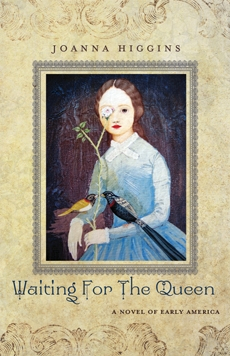History Lifts YA Fiction
*Waiting for the Queen* in the Spotlight
Waiting for the Queen
A Novel of Early America

Joanna Higgins
Milkweed Editions
Hardcover $16.95 (247pp)
978-1-57131-700-1
Buy: Local Bookstore (Bookshop), Amazon
Deserving of readers’ interest and sympathy, these two girls transform miraculously under the gifted hand of Joanna Higgins.
In Joanna Higgins’ first novel for young readers, Waiting for the Queen, thoughtfully created and dynamic characters give readers the unique perspectives and experiences of two very different girls during a less explored period in American history. Their journey to mutual understanding and commitment to equality unite the girls in a risky plan to ensure freedom for all in their community.
Eugenie de La Roque is horrified by her accommodations in America. The daughter of French nobles seeking asylum during the French Revolution, she’s used to a host of servants and plush bedding, not tiny log cabins and one maid who does not even curtsy. Still, Eugenie knows she and her family are lucky to be alive after the violent revolt of the peasants in France.
As for the de La Roque’s maid, she is a young Quaker girl named Hanna Kimbrell, who is hired—along with her brother, father, and other Americans—to work for the French. She is as mortified by the rude attitude of the French families as Eugenie is by her surroundings. Both girls grapple with their changing values as they become friends. When they see the harsh treatment of slaves, including a girl their own age, held by one of the noblemen, the girls are moved to do what they can to stop the vicious injustice.
Period details and historical events speak volumes about the careful research Higgins seems to have conducted. Everything from French hair fashions to American food storage is mentioned in an integrated way that creates rich realism. By including background information, such as Eugenie’s account of the revolution in France, Higgins also ensures that readers unfamiliar with the related time and events have a context to help immerse them in the novel.
While her setting creates an authentic stage, the author’s characters and their development will capture readers’ interest. Each girl is sympathetic from the start, a difficult feat with Eugenie, who easily could have come across purely vapid or petty. Both girls struggle with balancing what they know and the values of their families with the internal changes their circumstances encourage. It is particularly rewarding to see Eugenie become so much more open-minded and independent. Though perhaps not as prominently, Hannah also develops, finding the courage to speak up on behalf of her family and the slaves she has always seen as her equals.
Though occasionally the subplots feel a little wayward, they are actually quite instrumental in depicting the naturally evolving understandings of some of the settlers and Eugenie and Hannah’s friendship. There isn’t an extremely heightened escape scene with the slaves or an artificially dramatic climax. Rather, the book is a chronicle of events and moments, some subtle, that realistically paint the girls’ natural progression, as well the tone of the community.
Occasionally poetic language and themes of true human compassion, liberty, and courage top off this remarkable historical piece for middle school and, perhaps, early high school readers.
ALICIA SONDHI (August 31, 2013)
Alicia Sondhi
